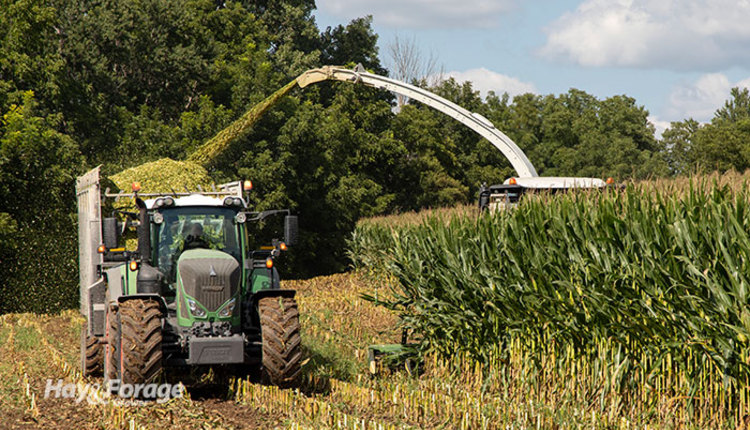
With corn silage harvest on the horizon, farmers will soon be able to assess their hybrid selection in terms of forage quality and yield. Some crop characteristics can be attributed to plant genetics or management practices, whereas others are more heavily influenced by the growing environment.
These factors make up the three-legged stool that support a successful corn silage crop. For instance, plant genetics differentiate standard hybrids from brown midrib (BMR) hybrids, good harvest management can optimize corn silage yield and starch content, and the growing environment is key to determining neutral detergent fiber digestibility (NDFD).
Adam Krull addressed these points in a recent webinar from Iowa State University Extension. The senior nutritionist for Pioneer noted how corn silage has gained popularity among dairy producers and become the primary ingredient in animal diets on many farms because of its ability to provide adequate energy and fiber.
“Corn silage is a total mixed ration plant,” Krull said. “It is a source of a lot of energy, and most of that energy comes from the grain, but that grain is also attached to a highly digestible grass. That makes for a really nice combination.”
Nearly 65% of corn silage is starch in the form of grain, but Krull emphasized the importance of NDFD in terms of energy density and dry matter intake. Although NDFD itself is not a strong selection trait because there tends to be little genetic variation between non-BMR hybrids, knowing how the growing environment affects NDFD can help guide corn silage hybrid selection in future years.
Precipitation patterns
In general, the timing and amount of moisture a field receives in the spring and early summer has the greatest influence on corn silage NDFD. For example, a wet start to the growing season will encourage corn to grow faster. This elevates lignin concentrations in plant cell walls as crops require more structural support for taller stalks, therefore reducing NDFD. On the other hand, drier conditions promote shorter stalks with lower lignin concentrations, thus allowing plants to have higher NDFD.
“When we have drier early season weather, we are going to have a much more digestible portion of the fiber. The moisture that we get after tassel is really what affects grain yield,” Krull stated. “If we could set the perfect year, we would be a little bit dry early on to have better NDFD. Then after tassel, we would have a bunch of rain to set a nice amount of grain.”
While moisture during vegetative stages impacts NDFD, so does late season plant health. To demonstrate this, Krull compared forage quality data of healthy stalks to that of diseased stalks. Within nine days, the NDFD of the diseased stalks dropped from 59.3 to 46.4 and undigested NDF (uNDF) rose from 25.3 to 34.1. There was no significant change in NDFD or uNDF of the healthy stalks over the same period.
Overall, choosing a corn silage hybrid with good basic agronomic traits and disease resistance will be more beneficial to achieve and maintain high NDFD. With that said, Krull suggested planting BMR corn to guarantee better NDFD no matter what Mother Nature brings.
BMR benefits
BMR corn has been shown to have up to 40% less lignin in plant cell walls compared to conventional hybrids. This improves NDFD, but it might impair drought tolerance, plant standability, and overall yield; however, Krull said the positives can outweigh the negatives.
“When we have increased fiber digestibility, the cow digests the fiber faster and the cow eats more. When the cow eats more, it produces more milk,” he said. “BMR corn from a nutritionist’s standpoint is very powerful for increasing milk production.”
To maximize crop success, plant BMR corn on highly productive soils as opposed to areas of a field that may have low soil fertility. Krull also suggested separating BMR corn silage piles from conventional corn silage piles so the former feedstuff can be allocated to the most productive lactating cattle.
Data from an experiment at the Miner Agricultural Research Institute in Chazy, N.Y., show feeding BMR corn silage to cows that produced 80 pounds of milk per day or less did not improve animals’ overall milk production, but it did boost milk production in cows that produced more than 80 pounds of milk per day. To expand upon this, Krull shared results from another study that show cows in milk at Day 50, 75, and 100 had the greatest response in milk production after being fed BMR corn silage compared to cows at other stages of lactation.
Considering the agronomic risks and the nutritional benefits of BMR corn, Krull recommended only planting 20% to 25% of total corn silage acres to this type of hybrid. This would limit the challenges associated with BMR corn while providing a higher quality feed for targeted cow groups.
“When we figure out how many acres we are going to need, we’ve got to remember we are going to have a little bit of yield drag and cows are going to eat a higher amount of corn silage,” Krull asserted. “We also need to have the ability to segregate corn silage piles and manage two separate bunker faces.”

